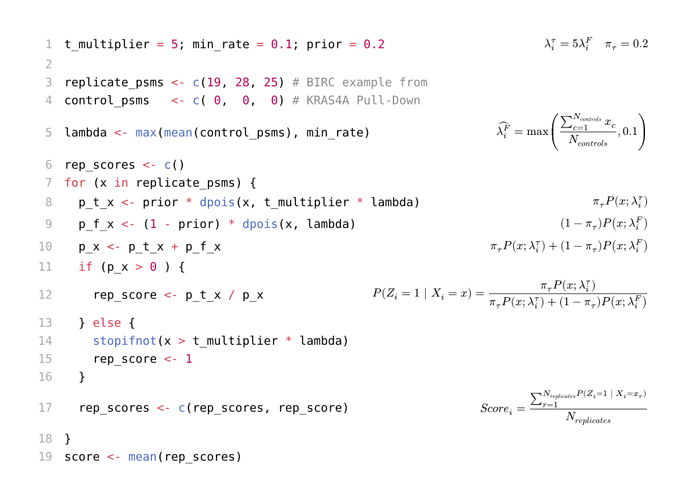Here is another, slightly more complex function to keep the code in one raw block (Please excuse any typos in the example):
#let annotate-code(code, annotations) = {
// Map the annotations to a dictionary for easy access
let dict = annotations.map(((row, a)) => (str(row), a)).to-dict()
let numbering = numbering.with("1")
show raw.line: it => context {
let num-width = measure(numbering(it.count)).width // Numbering shenanigens (not really necessary)
set block(spacing: 0em)
grid(
columns: (auto, 1fr, auto),
align: (right + horizon, left + horizon, right + horizon),
box(
width: num-width + 1em,
inset: (right: 1em),
text(fill: gray, numbering(it.number)),
),
it.body,
if str(it.number) in dict {
dict.at(str(it.number))
} else {
[]
},
)
}
code
}
You can then use the function as follows:
#annotate-code(
```R
t_multiplier = 5; min_rate = 0.1; prior = 0.2
replicate_psms <- c(19, 28, 25) # BIRC example from
control_psms <- c( 0, 0, 0) # KRAS4A Pull-Down
lambda <- max(mean(control_psms), min_rate)
rep_scores <- c()
for (x in replicate_psms) {
p_t_x <- prior * dpois(x, t_multiplier * lambda)
p_f_x <- (1 - prior) * dpois(x, lambda)
p_x <- p_t_x + p_f_x
if (p_x > 0 ) {
rep_score <- p_t_x / p_x
} else {
stopifnot(x > t_multiplier * lambda)
rep_score <- 1
}
rep_scores <- c(rep_scores, rep_score)
}
score <- mean(rep_scores)
```,
(
(1, $ lambda_i^tau = 5 lambda_i^F quad pi_tau = 0.2 $),
(
5,
$
hat(lambda_i^F) = max((sum_(c = 1)^(N_italic("controls")) x_c) / N_italic("controls"), 0.1)
$,
),
(8, $ pi_tau P(x; lambda_i^tau) $),
(9, $ (1 - pi_tau) P(x; lambda_i^F) $),
(10, $ pi_tau P(x; lambda_i^tau) + (1 - pi_tau) P(x; lambda_i^F) $),
(
12,
$
P(Z_i = 1 | X_i = x) = (pi_tau P(x; lambda_i^tau)) / (pi_tau P(x; lambda_i^tau) + (1 - pi_tau) P(x; lambda_i^F))
$,
),
(
17,
$
italic("Score")_i = (sum_(r = 1)^(N_italic("replicates") P(Z_i = 1 | X_i = x_r))) / N_italic("replicates")
$,
),
),
)
